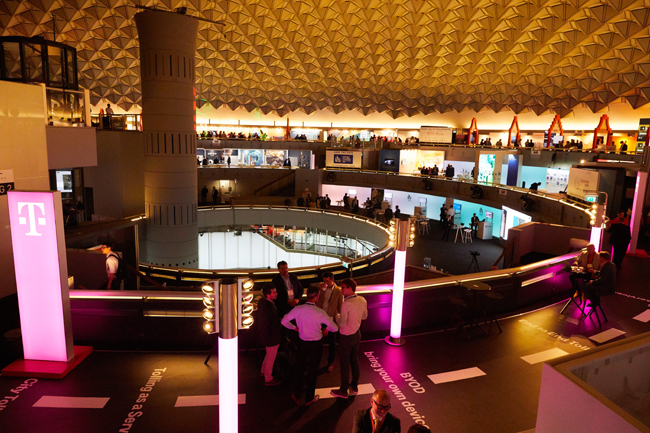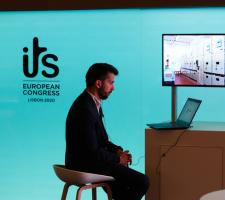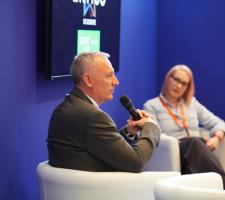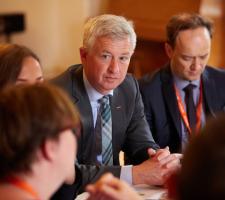
Navigating between the Evoluon conference centre - a former science museum that resembles a giant-sized UFO - and an automotive campus, there was a lot to see at the 13th ITS European Congress in Brainport, Eindhoven.
Organised by
More than 3,000 participants from over 50 countries gathered at the four-day event, which featured over 100 sessions and workshops as well as a range of demonstrations and tours.
The conference sessions included insights into who should own Mobility as a Service (
MaaS will not be for everyone
Not everyone will adopt MaaS solutions, so we still need to have legacy ways for people to reach the transport system to satisfy everyone. That was the message from Vasco Mora, an adviser to Lisbon's deputy mayor: “MaaS is great, and we need it, but we must not forget those that will not be included in whatever effort we make.”
In a session called Who Needs to Drive MaaS – Politics of Business, Volker Amann, CEO of consultancy company Avimo, told the audience that the public and private sector should work together but there are a lot of “pains of cooperating”.
Amann recommends that both parties should focus on “concrete goals” and sign an agreement which includes governance rules. “The focus should not be on clarifying every detail that could happen in the future, but they should focus on learning and improving together,” he continued. “This could be providing a wide variety of mobility offers that are supported and monetised by public authorities.”
According to Amann, Austria is focused on bringing MaaS to rural areas, a goal which will be difficult to achieve without the investment of billions of euros. “My approach is to create a regional MaaS ecosystem that involves the most important players and add value outside of mobility. For instance, this could be car dealers that may want to implement a car-sharing solution,” Amann added.
Monotch demonstrates C-ITS ecosystem
Elsewhere at ITS Europe, Monotch demonstrated how its Traffic Live Exchange platform (TLEX) is aiding the cooperative ITS (C-ITS) ecosystem in the Netherlands.
The company’s Jeroen Fokkema said: “This ride is not a test demo but how it is actually working in the Netherlands and we are rapidly increasing the number of connected devices, so by the end of the year there should 1,000 traffic lights connected.”
Monotch says the TLEX platform gathers large amounts of data from traffic lights and roadside equipment, allowing service providers to use cloud data to provide users with customised information while travelling.
Road users are connected via smartphones or navigation devices during their trip and can send data anonymously back to the cloud, and TLEX to the traffic lights.
This allows traffic operators to adjust traffic regulations based on the actual amount of traffic or give certain road users such as emergency services and heavy goods traffic priority over others.
For the demonstration, both roadside systems and applications from service providers are connected to the TLEX platform. The trip revealed a range of TLEX-connected traffic lights and a variable message sign from the province of Noord-Brabant and Noord-
Holland by suppliers
The data flow to the service providers was made visible via Dynniq's GreenFlow, a C-ITS application that provides smart support to road users. It works alongside V-Tron's Zoof Glosa app, which provides information on optimal driving speed and lane availability.
“The ecosystem is live in the Netherlands, meaning the infrastructure and the cloud platform is in place and its now a matter of scaling, that the road authorities and hardware manufacturers actually make their equipment smarter with 4G connectivity to connect to our platform,” Fokkema adds.
For local businesses, MaaS incentive programmes can allow participants to earn points for taking people on rides which can then be used to buy items from local shops. “The technical solution is there but politics and business need to cooperate and one good way to make a business case out of it is to create a regional MaaS ecosystem,” Amman concludes.
5G could save lives
New tooling offered by 5G could help lower casualty rates on Dutch roads, says the Ministry of Infrastructure and Water Management (IWM) in the Netherlands. At the session 5G and mobility – a match made in heaven? Caspar de Jonge, from the ministry’s directorate-general for mobility and transport, says: “We have seen our casualty rate climbing over the last few years to 650 fatalities on Dutch roads every year and that’s unacceptable.”
However, Jonge claimed that the mobility sector is not going to make the “rather large-scale investment in 5G completely sustainable”.
“There’s a lot of uncertainty in the sector and different business cases,” he continued. “So, we need a stack of different sectors outside of the mobility and traffic sector, but we can add to that and certainly use it to our advantage.”
Matthias Sauder, director network mobile at VodafoneZiggo, predicted that mission-critical services will be the “next big thing to come”, an area which he insisted is not just about connecting cars. “It’s really about enabling solutions and production entities where we can also make use of certain technological capabilities which are somehow embedded in 4G but will be more embedded in 5G, particularly in terms of reduced latency,” he added.
According to Sauder, the customer will receive an increase in user speeds and spectrum efficiency, resulting in higher traffic capacity and connection density. “I urge everyone to everybody to work in this ecosystem and partner as it’s very important to get the requirements clear and then to derive standards from it,” he concluded.
Co-operative traffic management
Elsewhere at the ITS European Congress, the issues around cooperative traffic management were chewed over at Enabling interactive traffic management through public-private cooperation: examples from practical trials.
In essence, the feeling of the session is that it needs to be more de-centralised rather than a ‘Big Brother of mobility’ approach that watches over our every movement. Pedro Barradas, policy officer at DG Move, the directorate-general for mobility and transport at the European Commission (EC), said discussions were held on how to enhance traffic management in the future and on the basis for co-operation.
Barradas explained that the EC worked to address a lot of issues to prevent cooperation and technical gaps in between to promote the right trust between partners.
“Automated vehicles will be computers on wheels and will need to be taught how to behave on the roads, so most of the traffic regulations will have to have a digital twin in a machine-readable format. This will allow the interaction between the road and the intelligent vehicle to happen as intended,” he added.
However, Barradas emphasised the importance of talking about intentions, as everything from where the lane merges to going in and out of intersections are “points of contact which need to be negotiated”.
“Overall, there was a notion that public authorities need to preserve the role of their authority because they somehow set the regulations for accessing the infrastructure and they regulate how mobility takes place,” he continued. “So co-operative traffic management will need to be well orchestrated because they depend on the combined efforts by the public and private sector to really build a value chain that is in line with the mobility policy that we want to develop.”
SkedGo partners with Fluidtime
Mobility company
SkedGo says its mobility platform can combine all public, commercial and private transport modes into smart trip chains, with priority settings for time, carbon and money.
Fluidtime’s mobility solution, Fluidhub, is aimed at helping cities and public transport companies install and operate integrated mobility services.
John Nuutinen, SkedGo's chief business development officer, said the partnership integrates the company's trip planning and multi-modal capabilities with Fluidtime's “stronger” portfolio of products which carry out the transaction process.
“The major benefits for us is that we are leveraging capabilities that would take longer and be more expensive to produce,” he continues. “For customers, it’s affordable and vast, and we can get them to market very quickly.”
Nuutinen claims that small- to medium-sized enterprises are currently looking to get more competitive as the market is starting to catch up with the technology.
“We think customers are getting more comfortable with MaaS and the industries that are being disrupted are starting to participate in this as well, as they don't see any other alternative,” he concludes.
Zero emissions for heavy-duty hybrids
Heavy-duty hybrid vehicles in the future may need to switch to zero emissions when entering a city - and be competitive in their total cost of ownership.
Steven Wilkins, senior research scientist at research group
“Connected to that is downsizing the engine,” he said. “We very much want to increase the electric range of these types of vehicles much more significantly than at present.”
TNO is responsible for the overall technical coordination of ORCA, an initiative which seeks to design greener and affordable hybrid drivetrains for heavy-duty vehicles.
“Within a city area, perhaps supported by a lot of charging infrastructure, you may have the ability for the vehicles to be highly electric, and for longer distances we stay more with a more liquid fuel,” he continued. “But there is a whole class of vehicles that need to operate within the city centre but have the extended range of longer distances, so this mixed functionality becomes important for being able to predict ahead exactly what the vehicle is going to do.”
According to Wilkins, ORCA adopts a co-design approach which considers the energy management strategy and optimal control: “But in terms of the development of these vehicles, we want to think about the technology and sizing of the components. How big does the battery really need to be and what type of hybrid are we talking about?”
Wilkins asks what data may be required from the cities to impose on the vehicle to safeguard that ‘zero emission’ is really happening: “Do we want to go that far? Should we put the real burden on the driver or end user and how do we prove that that's acceptable? These are still complex discussions both at the political and technical level but they all come down to data in the end.”
TmaaS project open to cities
Speaking at Large-scale deployment new mobility services in smart cities: create market & impact, Stephanie Leonard, TomTom’s strategic business development manager, says Ghent faces challenges on budget limitations and rising congestion and pollution.
“However, the city did not want to use traditional ways of managing traffic such as using a traffic management control centre,” she continues. “Rather than investing in hardware such as loops and cameras, they were interested in making use of data and working with the private sector to manage the mobility system.”
Leonard explains that the TmaaS project was introduced to utilise all the data available from the public side and licensing from the private side, allowing it to manage the mobility from a dashboard.
Ghent used the Tmaas platform to communicate with citizens using their mobile phone to provide information on services via social media channels and engage with people while also using TomTom to help drivers navigate in their cars.
“The other big service they are focusing is on is the assistant management panel which provides real-time information on how the city is working and what decisions they need to make mobility more optimised and integrated,” she continued. “This includes closing roads and reducing speed limits and all those types of measures that cities have to make.”
As part of the project, TomTom can fund three additional projects for one year to use the TmaaS platform. “For the partners of the project which include TomTom and Be Mobile, we want to see if there is an opportunity to scale this project across Europe as this solution is not Ghent-specific; it can work in any city”, she added.
Mobility labs: learning through experience
“Real problems” need to emerge in the development of an urban mobility lab before you can begin to find solutions, according to Raimo Tengvall, project manager of Forum Virium Helsinki.
Tengvall shared lessons learned from the company’s Jätkäsaari urban mobility lab in the Finnish capital.
“In the Jätkäsaari area we were having eight million passengers going through a street network of a new residential area where there is a new school and that’s a real problem,” he told the audience at Urban Mobility Labs – lessons learned from practical real-world testbeds. “And now we have those problems to solve.”
One of the main messages from the session was that urban mobility labs are being used to provide solutions to cities and to help businesses grow.
Paul Blakeman, head of innovation at UK-based innovation consultancy Urban Foresight, echoed the mood when referring to an initiative in the Scottish city of Dundee.
“The whole city is effectively the living lab and there are a lot of people with opinions and interest in terms of how mobility systems run,” he said. “Actually, it took us a lot longer to get any pilots on the ground than I was thinking because we had to go through another round of engaging with local councillors and bus operators.”
When asked to offer advice to those interested in setting up a mobility lab, Blakeman recommended that lab teams should use the transport in the city and engage with a diverse group of citizens as they “will care about the challenges”.
“Listen to the end users and the companies rather than the cities - as the cities should be the enablers,” Tengvall concluded.
Orolia focuses on simulation
Orolia, a company specialising in resilient positioning, navigation and timing (PNT), displayed solutions to help protect and enable ITS operations.
The company says its Orolia GSG simulator offers GNSS with multi-constellation coverage and can generate the same RF signals that are broadcast by navigation satellites to test devices and systems with a GPS receiver.
Frederic Silva, Orolia's business development director, global intelligent transport systems, said the simulations help people building applications and embedding GNSS receivers in detecting malicious interferences coming from the spectrum - called GPS jamming and GPS spoofing.
“These people can damage the reception of the GPS signals and jeopardise some critical applications or even change the position or timing information data,” he continued. “It could be something like a glitch into your smartphone, but when we are talking about autonomous driving and we want to have 10-2cm positioning accuracy, if someone is messing up the position of the signal, the result could be far worse.”
Orolia’s Broadsim simulator offers support for advanced jamming and spoofing. Powered by the firm’s Skydel SDX GNSS simulation technology, it is expected to simulate multi-frequency and multi-GNSS signals.
For jamming/spoofing detection and mitigation, Orolia's BroadSense solution can be used in vulnerability testing to help users understand how systems will react to jamming and spoofing. Also, the ThreatBlocker platform can be used to provide inline protection.
“We have technology that can help and our best message to the market is to put some probes to detect it and see by yourself,” Silva concluded. “Once you get this, take the time to make the proper simulation through a secure environment and see how your infrastructure is resilient and how it reacts and once you get here, then protect yourself.”









